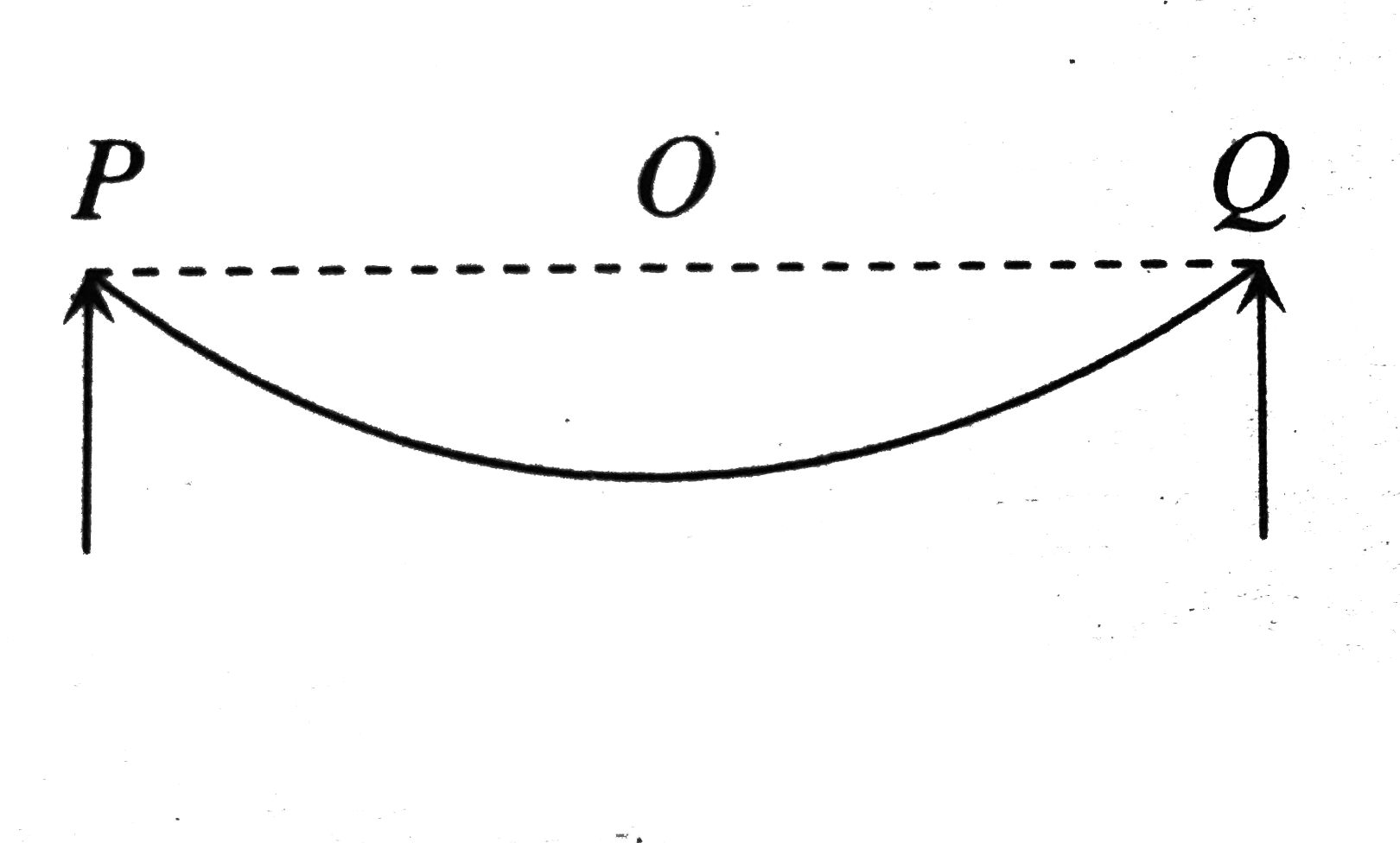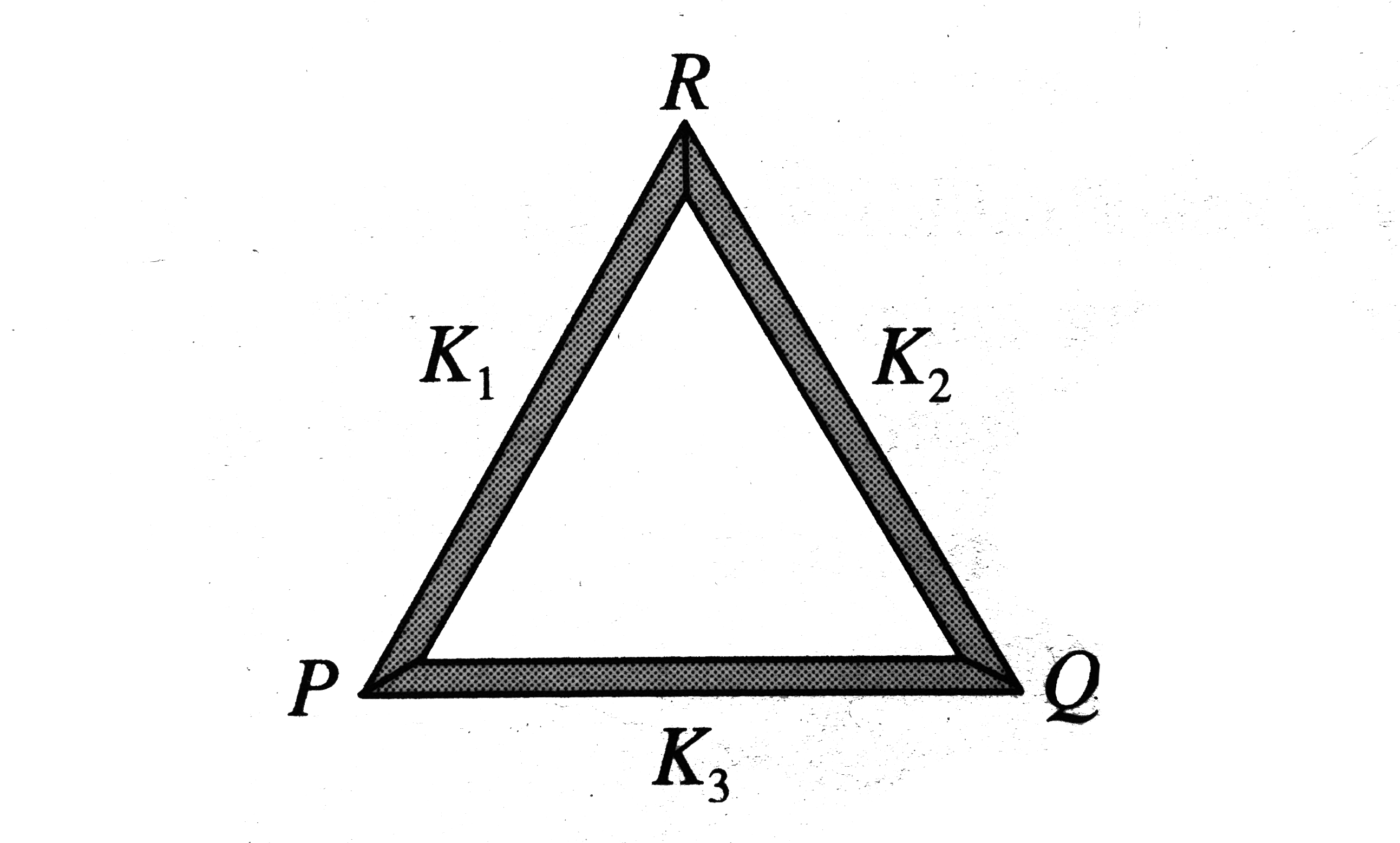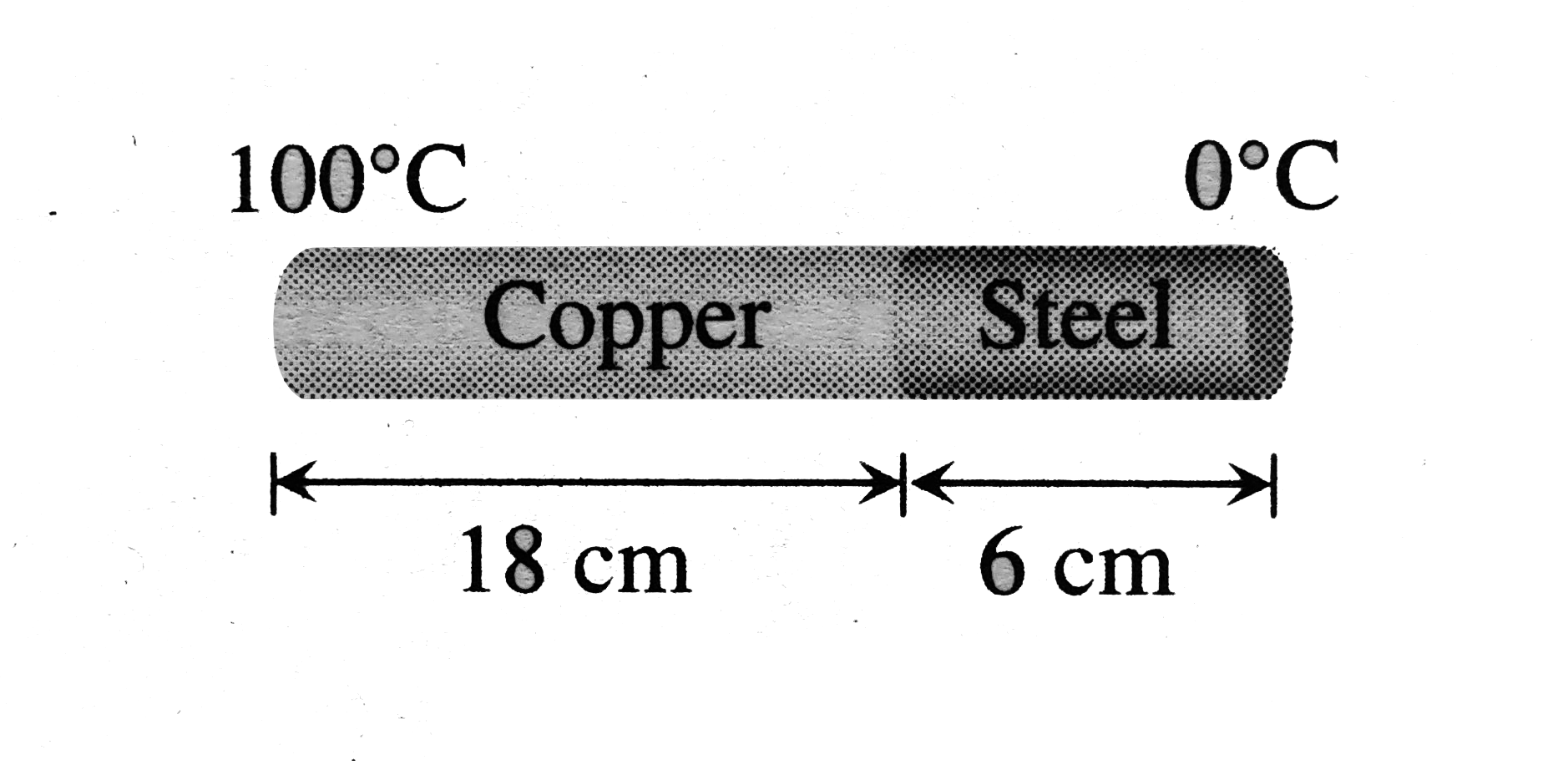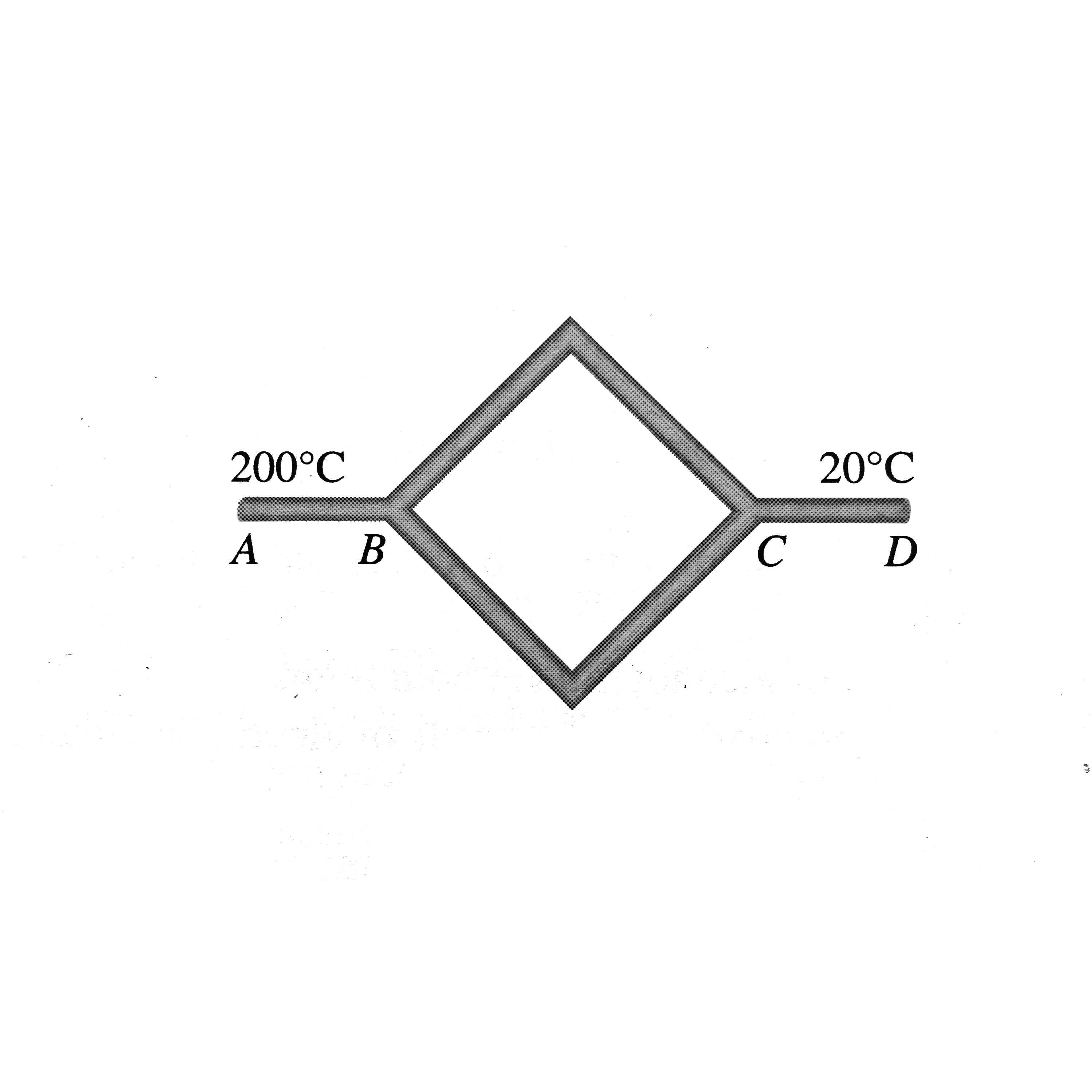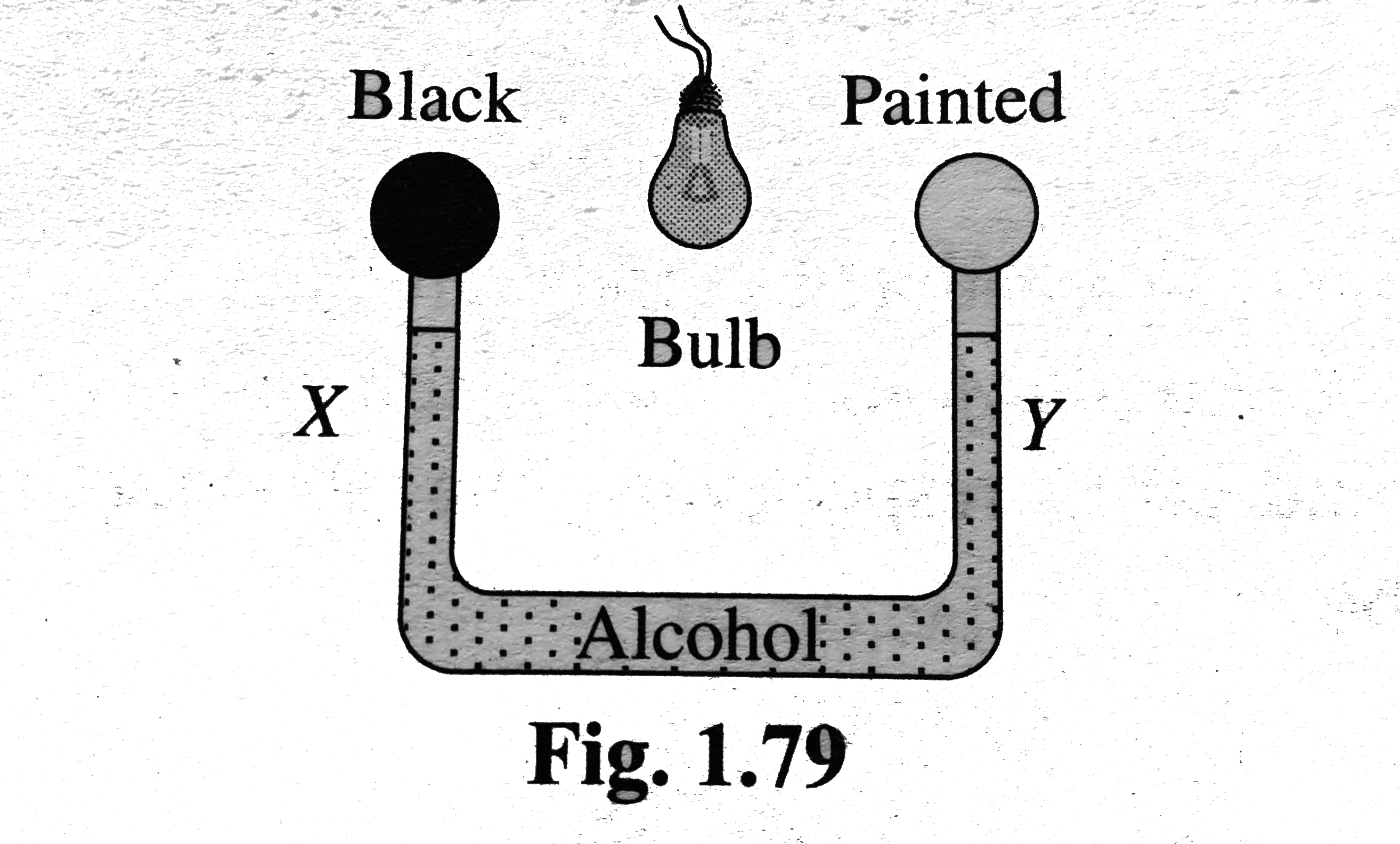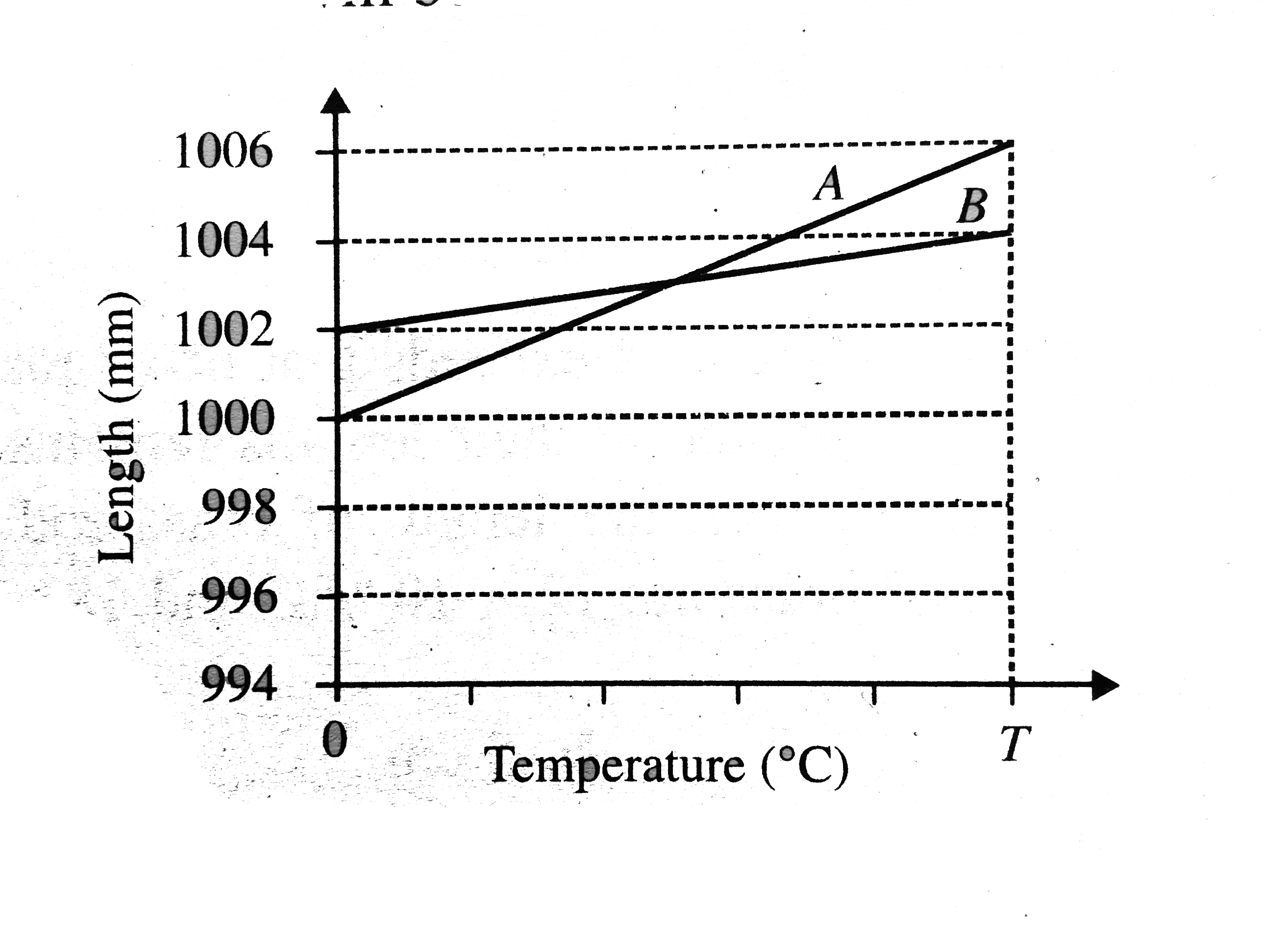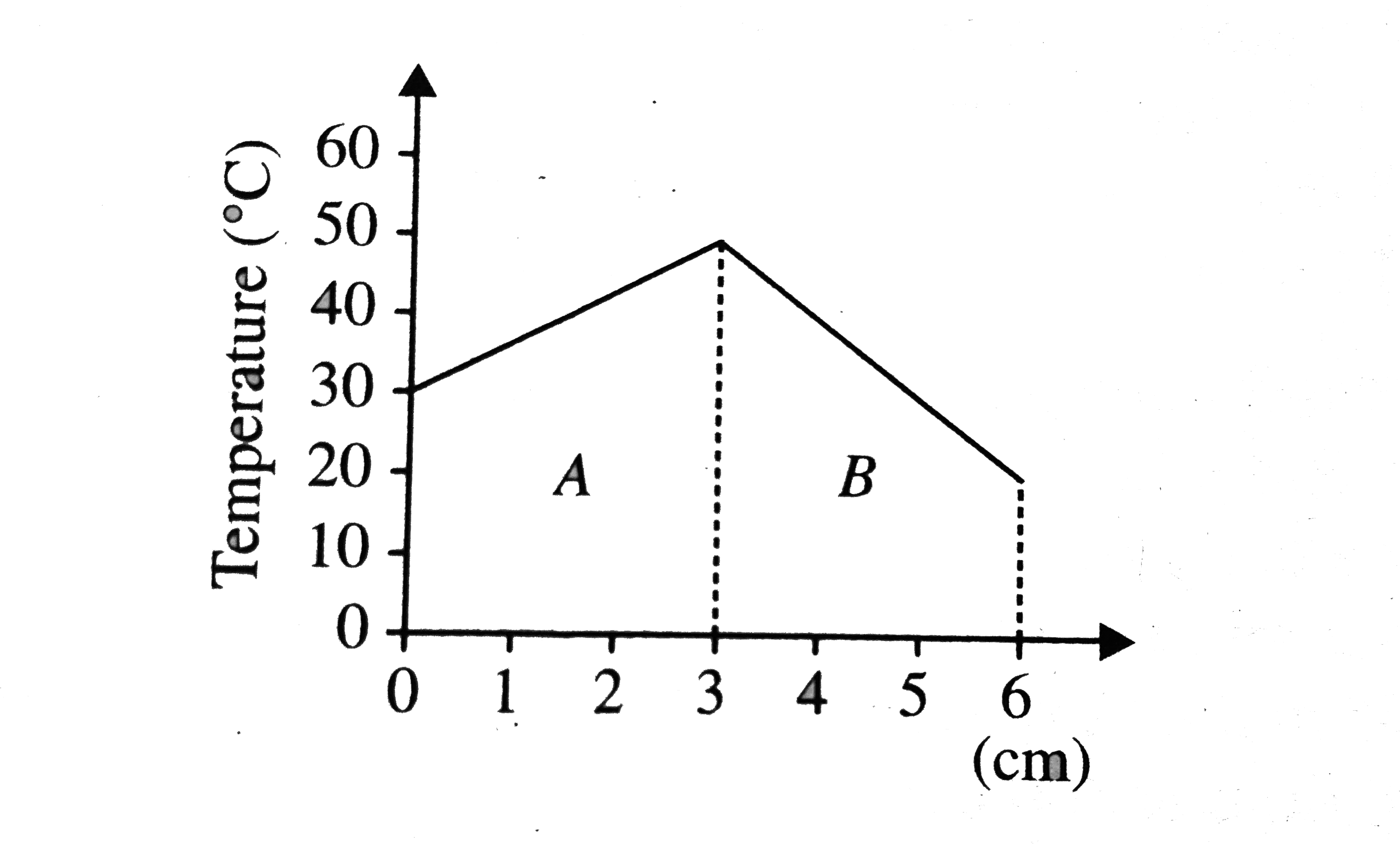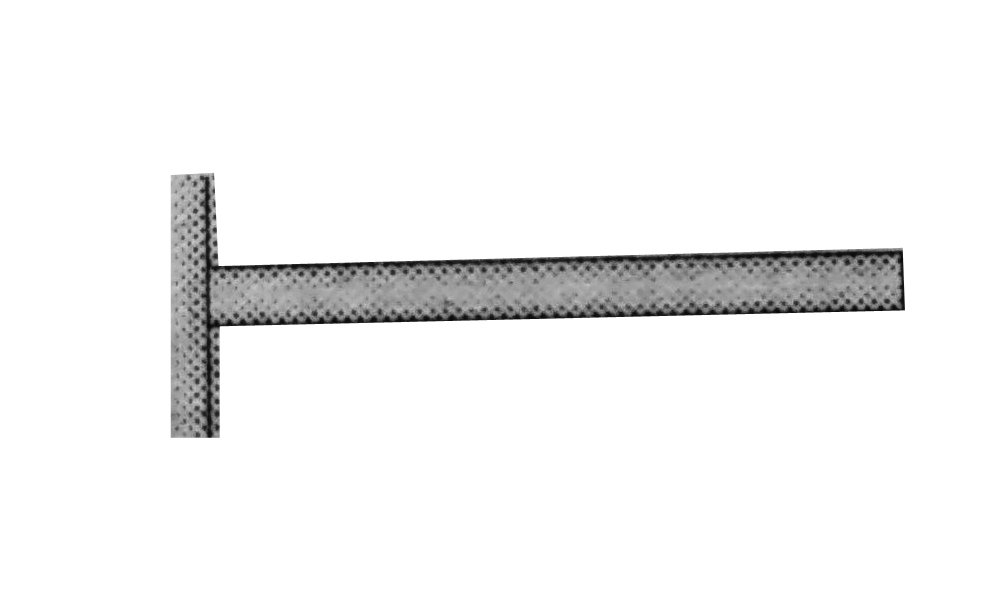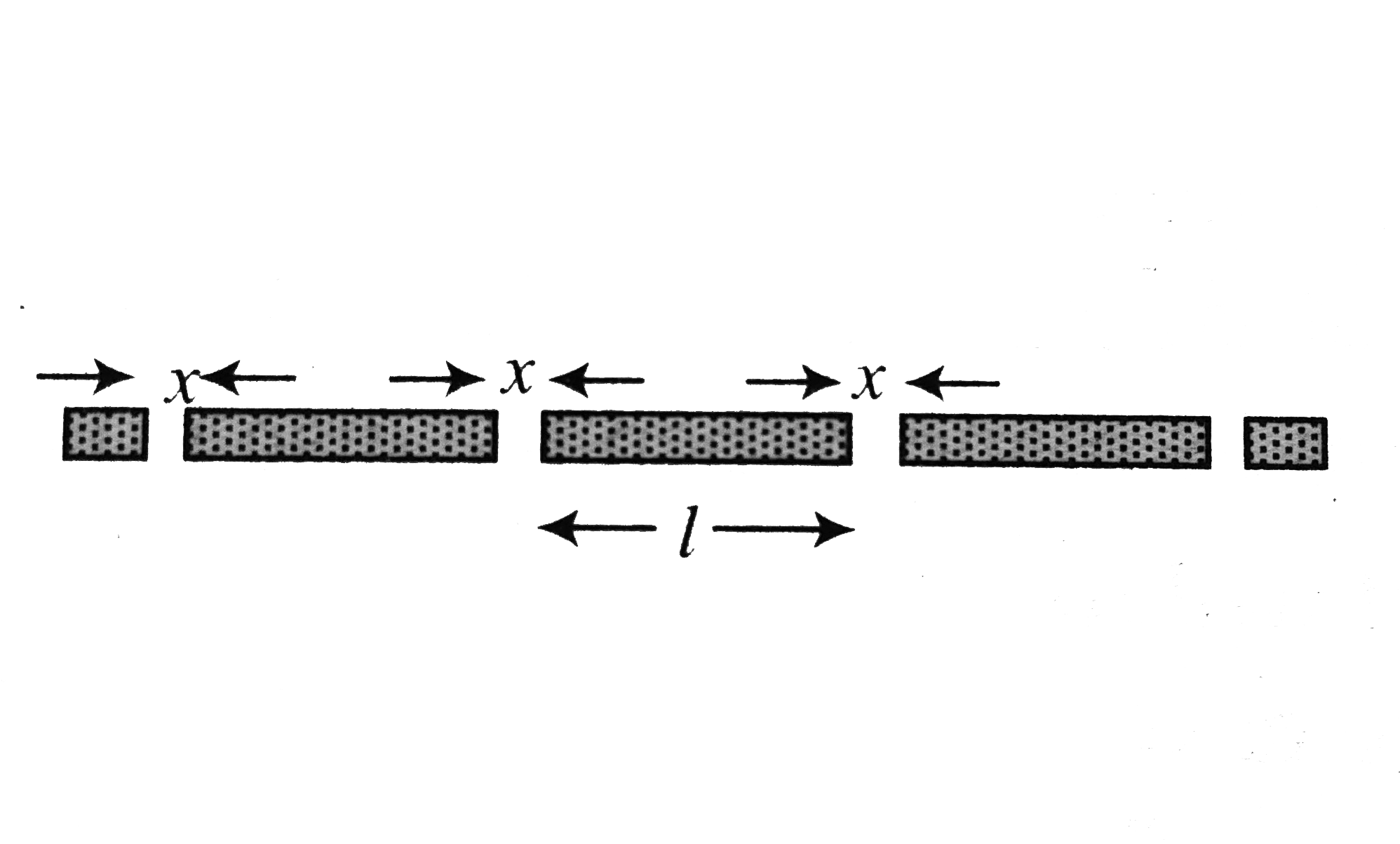Single Correct from CENGAGE PHYSICS Chapter 4 CALORIMETRY for Class 11
| Class 11 | PHYSICS |
| Chapter | CALORIMETRY |
| CENGAGE PHYSICS | Single Correct |
| Medium | English |
| Academic Year | 2023-2024 |
Question 2
An isosceles triangles is formed with a thin rod of length l1 and coefficient of linear expansion α1, as the base and two thin rods each of length l2 and coefficient of linear expansion α2 as the two sides. The distance between the apex and the midpoint of the base remain unchanged as the temperature is varied. The ratio of lengths l1l2 is
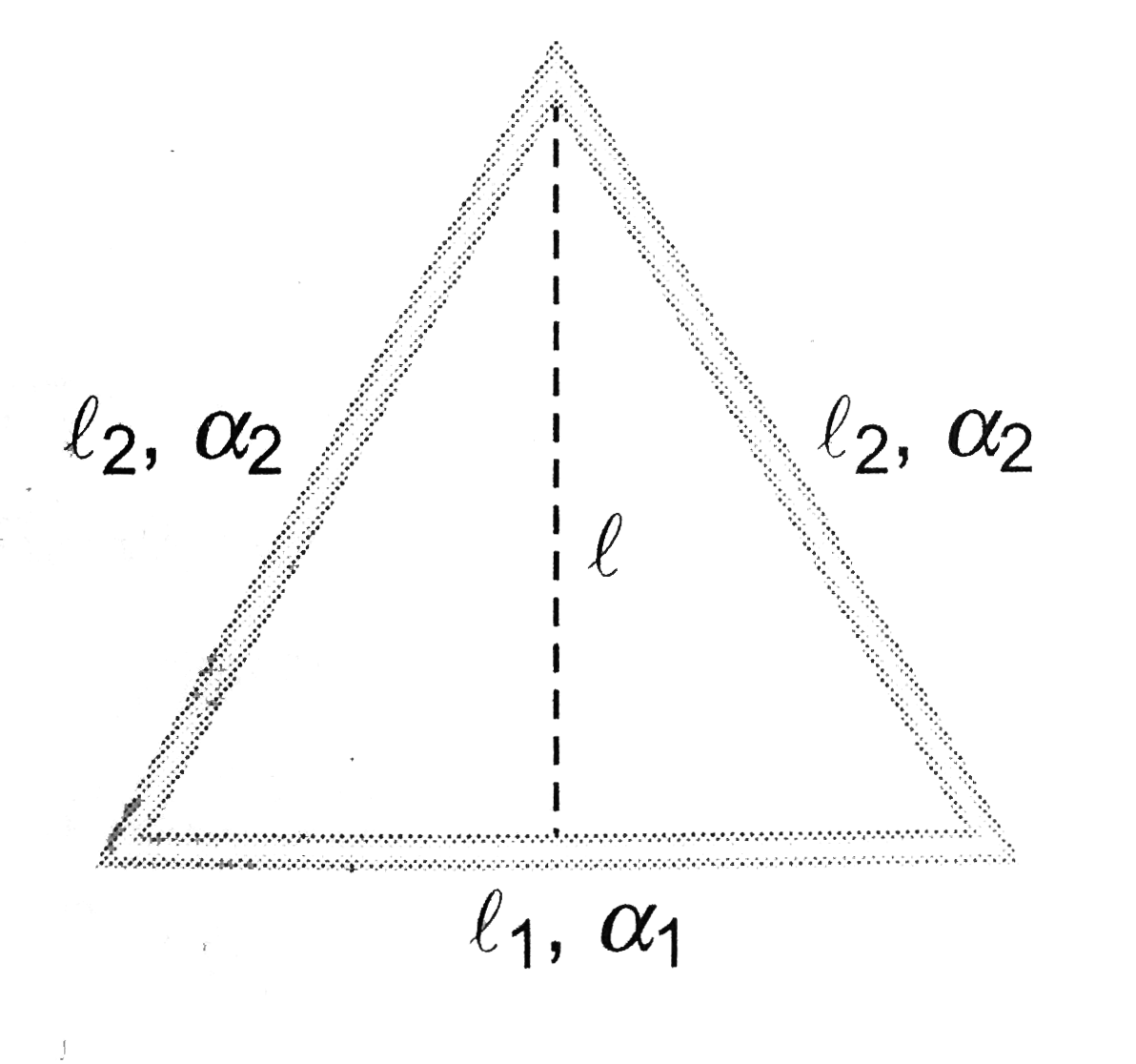 View Solution
View SolutionQuestion 3
An iron rod of length 50 cm is joined at an end to aluminium rod of length 100 cm. All measurements refer to 20_0 C . Find the length of the composite system at 1000 C. and its average coefficent of linear expansion. The coefficient o f linear expansion o f iron and aluminium are 10 xx 10_-6 0 C_-1 and 24 xx10_-6 0 C _-1 respectively.View SolutionQuestion 22
In an industrial process 10 kg of water per hour is to be heated from 20∘C to 80∘C. To do this steam at 150∘C is passed from a boiler into a copper coil immersed in water. The steam condenses in the coil and is returned to the boiler as water at 90∘C. How many kilograms of steam is required per hour (specific heat of steam=1cal/g∘C, Latent heat of vapourization=540cal/g)?View SolutionQuestion 25
A semicircular rods is joined at its end to a straight rod of the same material and the same cross-sectional area. The straight rod forms a diameter of the other rod. The junctions are maintained at different temperatures. Find the ratio of the heat transferred through a cross section of the semicircular rod to the heat transferred through a crossection of the straight rod in a given time. View SolutionQuestion 28
A point source of heat of power P is placed at the centre of a spherical shell of mean radius R. The material of the shell has thermal conductivity K. If the temperature difference between the outer and inner surface of the shell in not to exceed T, the thickness of the shell should not be less than .......View SolutionQuestion 29
There are three thermometers one in contact with the skin of the man other in between the vest and the shirt and third in between the shirt and coat. The readings of the thermometers are 30∘C,25∘C and 22∘C, respectively. If the vest and the shirt are of the same thickness, the ratio of their thermal conductivities isView SolutionQuestion 34
An ice box used for keeping eatables cool has a total wall area of 1m2 and a wall thickness of 5.0 cm. The thermal conductivity of the ice box is K=0.01J/m∘C. It is filled with large amount of ice at 0∘C along with eatables on a day when the temperature is 30∘C The latent heat of fusion of ice is 334×103J/kg. The amount of ice melted in one day is ( 1 day=86,000s)View SolutionQuestion 35

The only possibility of heat flow in a thermos flask is through its cork which is 75cm2 in area and 5 cm thick its thermal conductivity is 0.0075cal/cm−s−∘C. The outside temperature is 40∘C and latent heat of ice is 80cal/g. Time taken by 500 g of ice at 0∘C in the flask to melt into water at 0∘C is View SolutionQuestion 42
A solid copper cube of edges 1 cm is suspended in an evacuated enclosure. Its temperature is found to fall from 100∘C to 99∘C in 100 s. Another solid copper cube of edges 2 cm, with similar surface nature, is suspended in a similar manner. The time required for this cube to cool from 100∘C to 99∘C will be approximatelyView SolutionQuestion 50
There are two thin spheres A and B of the same material and same thickness. They behave like black bodies, Radius of A is double that of B and Both have same temperature T. When A and B are kept in a room of temperature T0(<T), the ratio of their rates of cooling is (assume negligible heat exchange between A and B).View SolutionQuestion 51
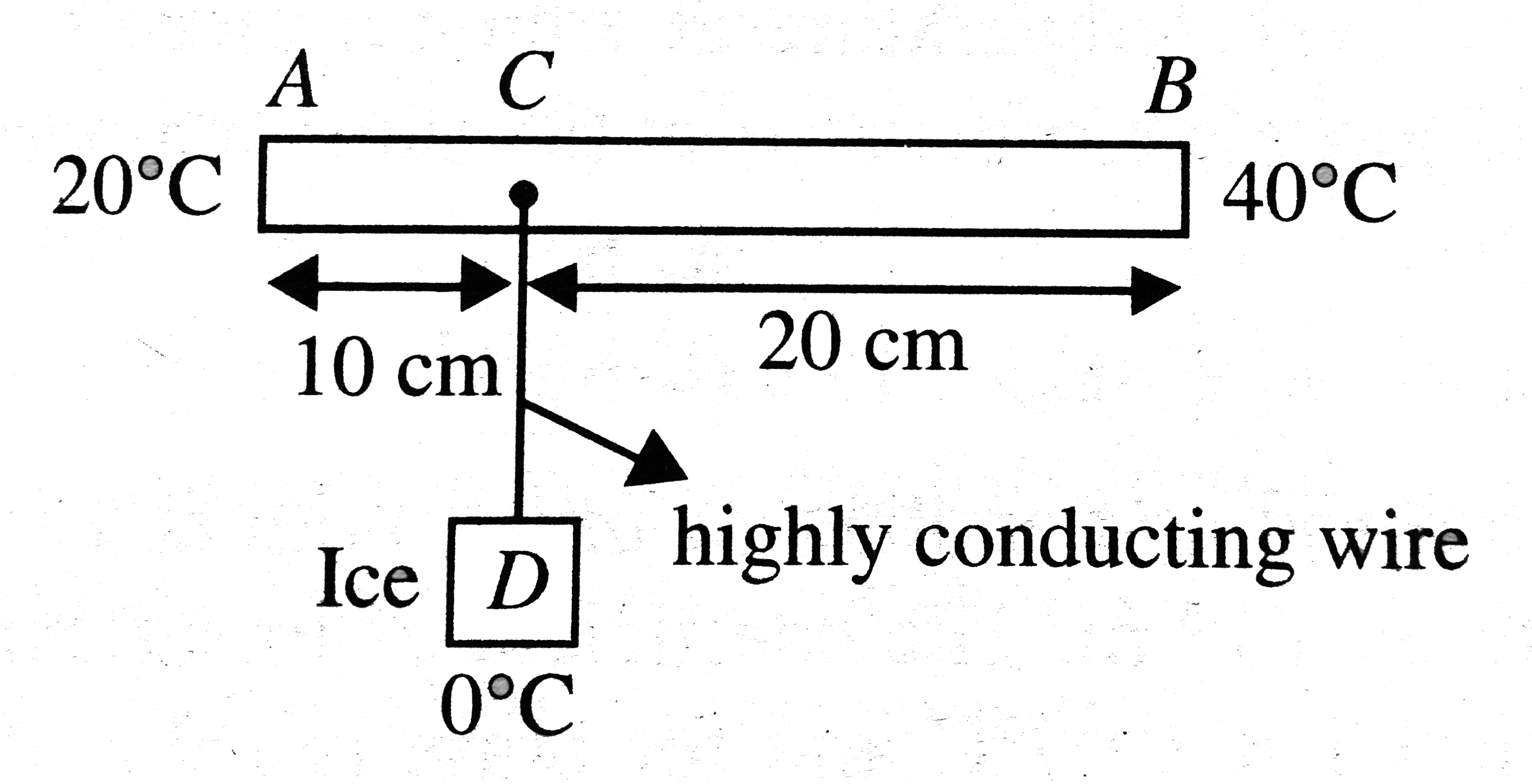
As shown in Fig. AB is rod of length 30 cm and area of cross section 1.0cm2 and thermal conductivity 336 SI units. The ends A and B are maintained at temperatures 20∘C and 40∘C, respectively .A point C of this rod is connected to a box D, containing ice at 0∘C through a highly conducting wire of negligible heat capacity. The rate at which ice melts in the box is (assume latent heat of fusion for ice Lf=80cal/g)View SolutionQuestion 55
A solid metallic sphere of diameter 20 cm and mass 10 kg is heated to a temperature of 327∘C and suspended in a box in which a constant temperature of 27∘C is maintained. Find the rate at which the temperature of the Sphere will fall with time. Stefan's constant=5.67×10−8W/m2/K4 and specific heat of metal =420J/kg/∘C.View SolutionQuestion 57
A wire is made by attaching two segments together end to end. One segment is made of aluminium and the other is steel. The effective coefficient of linear expansion of the two segment wire is 19×10−6/∘C. The fraction length of aluminium is (linear coefficient of thermal expansion of aluminium and steel are 23×10−6.∘C and 12×10−6/∘C,View SolutionQuestion 61
A thread of liquid is in a uniform capillary tube of length L. As measured by a ruler. The temperature of the tube and thread of liquid is raised by ΔT. If γ be the coefficient of volume expansion of the liquid and α be the coefficient of linear expansion of the material of the tube, then the increase ΔL in the length of the thread, again measured by the ruler will be View SolutionQuestion 62
A brass wire 2 m long at 27∘C is held taut with negligible tension between two rigid supports. If the wire is cooled to a temperature of −33∘C, then the tension developed in the wire, its diameter being 2 mm, will be (coefficient of linear expansion of brass=2.0×10−5/∘C and Young's modulus of brass =0.91×1011Pa)View SolutionQuestion 63
A mass m of lead shot is placed at the bottom of a vertical cardboard cylinder that is 1.5 m long and closed at both ends. The cylinder is suddenly inverted so that the shot falls 1.5 m If this procces is repeated quickely 100 times, auuming no heat is dissipated or lost, the temperature of the shot will increase by (specific heat of lead=0.03cal/g∘C)View SolutionQuestion 64
An iron rocket fragment initially at −100∘C enters the earth's atmosphere almost horizontally and quickly fuses completely in atmospheric friction. Specific heat of iron is 0.11kcal/kg∘C. Its melting point is 1535∘C and the latent heat of fusion is 3kcals/kg. The minimum velocity with which the fragmento must have entered the atmosphere isView SolutionQuestion 65
A liquid of density 0.85g/cm3 flows through a calorimeter at the rate of 8.0cm2/s. Heat is added by means of a 250 W electric heating coil and a temperature difference of 15∘C is established in steady state conditions between the inflow and the outflow points of the liquid. The specific heat for the liquid will beView SolutionQuestion 66
An iron ball (coefficient of linear expansion=1.2×(10−5/∘C) has a diameter of 6 cm and is 0.010 mm too large to pass through a hole in a brass plate (coefficient of linear expansion=1.9×10−5/∘C) when the ball and the plate are both at a temperature of 30∘C At what common temperature of the ball and the plate will the ball just pass through the hole in the plate ?View SolutionQuestion 67
A flask of mercury is sealed off at 20∘C and is completely filled with mercury. If the bulk modulus for mercury is 250 Mpa and the coefficient of volume expansion of mercury is 1.82×10−4/∘C and the expansion of glass is ignored, the pressure of mercury within flask at 100∘C will be View SolutionQuestion 70
An ordinary refrigerator is thermally equivalent to a box of corkboard 90 mm thick and 5.6m2 in inner surface area. When the door is closed, the inside wall is kept, on the average, 22.2∘C below the temperature of the outside wall. If the motor of the refrigerator runs 15% of the time while the door is closed, at what rate must heat be taken from the interior whicle the motor is running?
The thermal conductivity of corkboard is k=0.05W/mK.View SolutionQuestion 71
A bullet of mass 5 g moving at a speed of 200 m/s strikes a rigidly fixed wooden plank of thickness 0.2m normally and passes through it losing half of its kinetic energy. If it again strikes an identical rigidly fixed wooden plank and passes through it, assuming the same resistance in the two planks the ratio of the thermal energies produced in the two planks is View SolutionQuestion 72

A and B are tqo isolated spheres kept in close proximity so that they can exchange energy by radiation. The two spheres have identical physical dimensions but the surface of A behaves like a perfactly black body while the surface of B reflects 20% of all the radiations it receives. They are isolated from all other sources of radiation.View SolutionQuestion 73
A thermally isulated piece of metal is heated under atmospheric pressure by an electric current so that it receives electric energy at a constant power P. This leads to an increase of absolute temperature T of the metal with time t as follows:
T(t)=T0[1+a(t−t0)]1/4. Here, a, t0 and T0 are constants. The heat capacity Cp(T) of the metal is View SolutionQuestion 74
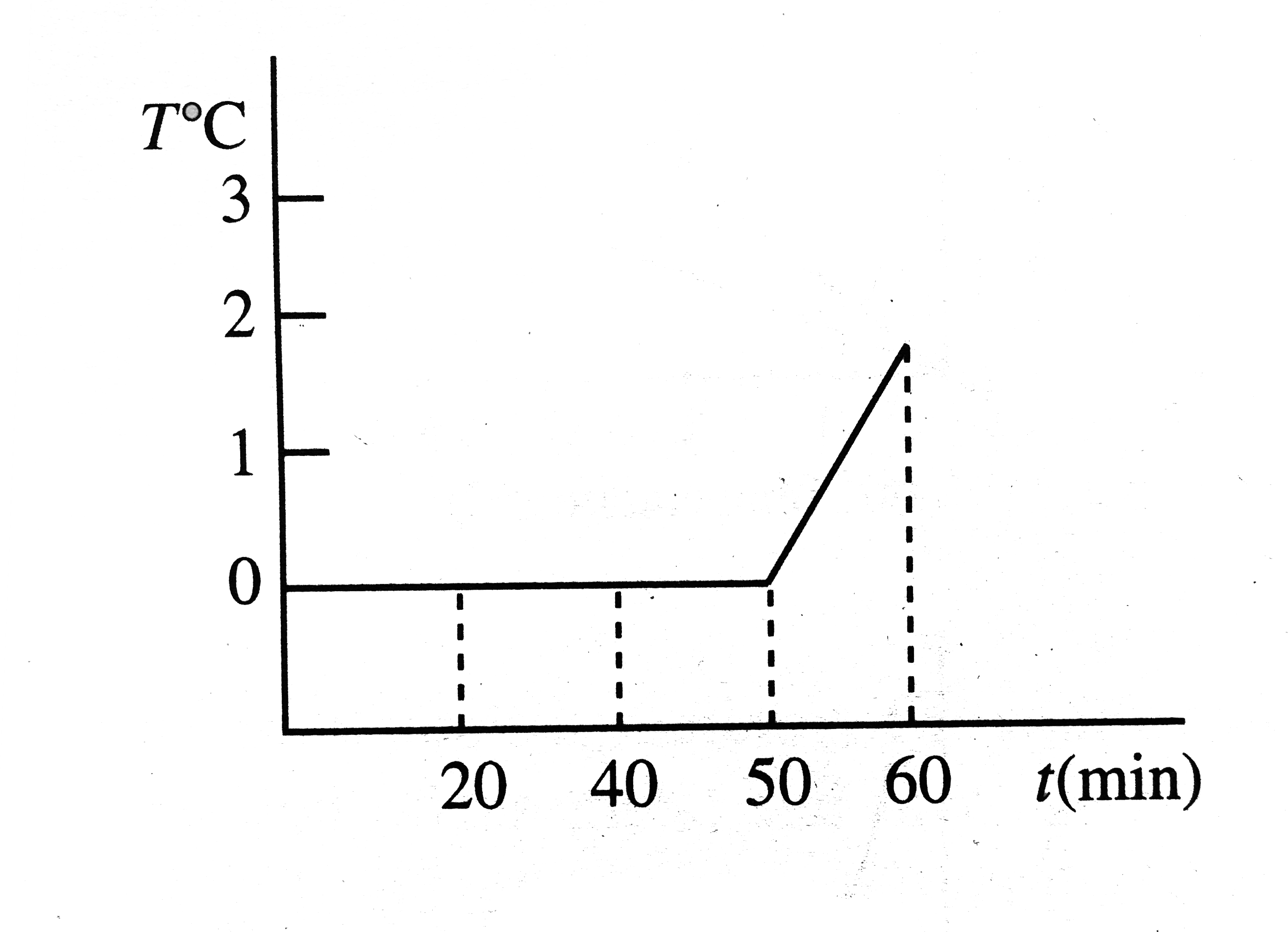
A cooking vessel on a slow burner contains 5 kg of water and an unknown mass of ice in equilibrium at 0∘C at time t=0. The temperature of the mixture is measured at various times and the result is plotted as shown in Fig. During the first 50 min the mixture remains at 0∘C. From 50 min to 60 min, the temperature increases to 2∘C Neglecting the heat capacity of the vessel, the initial mass of the ice isView SolutionQuestion 75
A glass cylinder contains m0=100g of mercury at a temperature of t0=0∘C. When temperature becomes t1=20∘C the cylinder contains m1=99.7g of mercury The coefficient of volume expansion of mercury γHe=18×(10−5/∘C Assume that the temperature of the mercury is equal to that of the cylinder. The corfficient of linear expansion of glass α is View SolutionQuestion 77
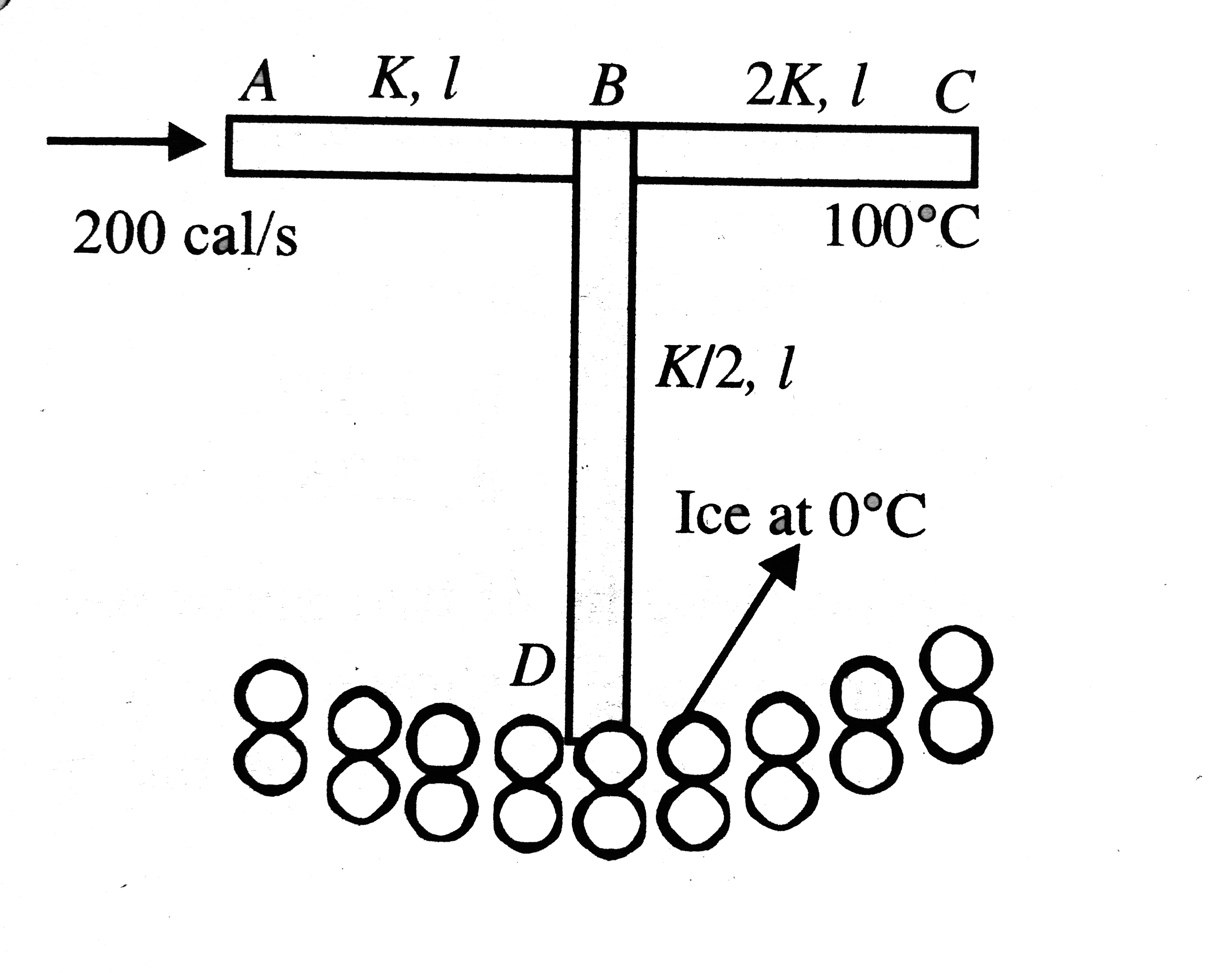
Three rods AB, BC and BD of same length l and cross section A are arranged as shown. The end D is immersed in ice whose mass is 440 g and is at 0∘C. The end C is maintained at 100∘C. Heat is supplied at constant rate of 200 cal/s. Thermal conductivities of AB, BC and BD are K, 2K and K/2, respectively Time after which whole ice will melt is (K=100cal/m−s∘CA=10cm2,l=1cm)View SolutionQuestion 79
A container of capacity 700 mL is filled with two immiscible liquids of volume 200 mL and 500 mL with respective volume expansivities as 1.4×10−5/∘C and 2.1×10−5/∘C. During the heating of the vessel, it is observed that neither any liquid overflows nor any empty space is created. The volume expansivity of the container is View SolutionQuestion 85
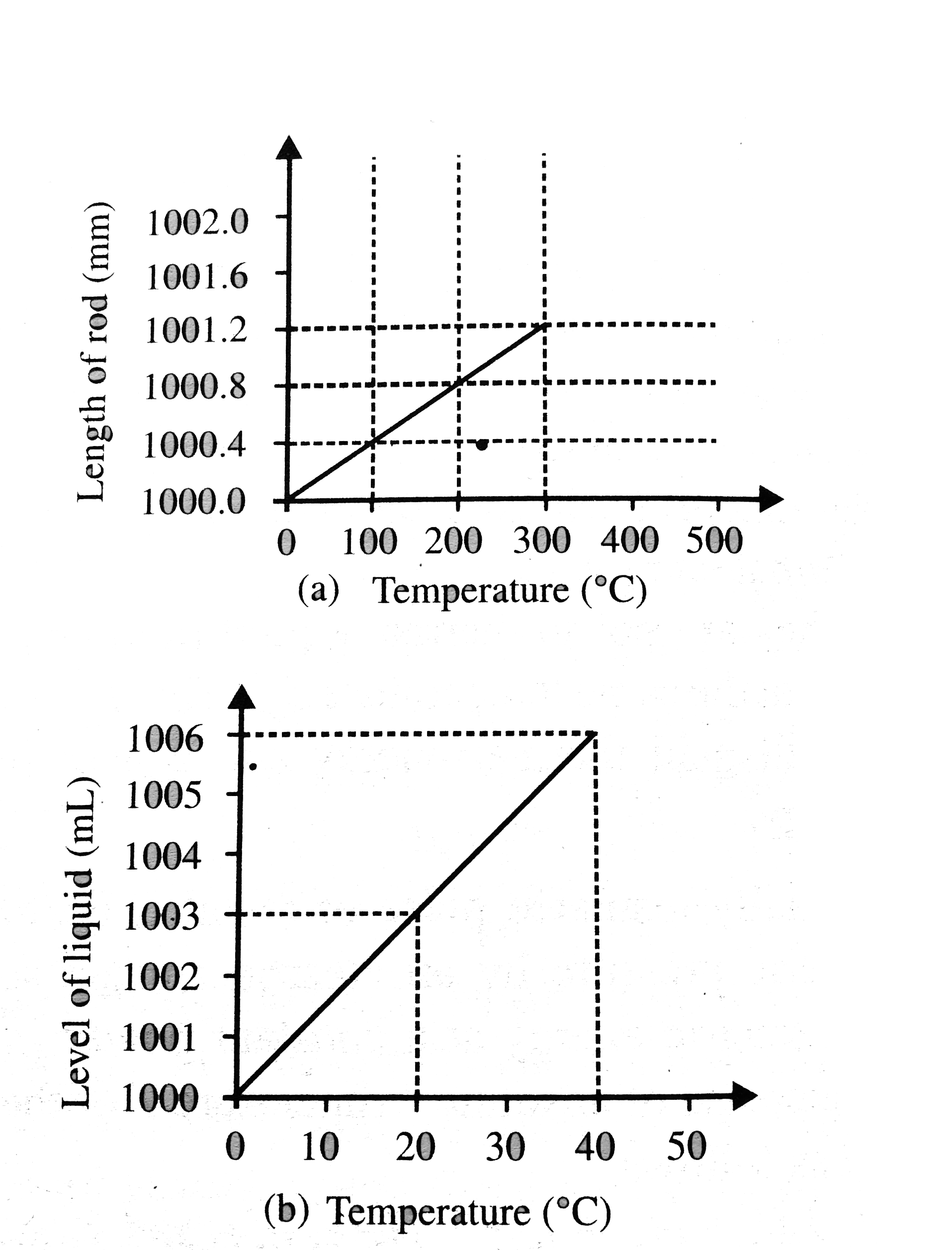
The graph of elongation of rod of a substance A with temperature rise is shown if Fig. A liquid B contained in a cylindrical cessel made up of substance A, graduated in millilitres at 0∘C is heated gradually. The readings of the liquid level in the vessel corresponding to different temperatures are shown in the figure. the real volume expansivity of liquid isView SolutionQuestion 86
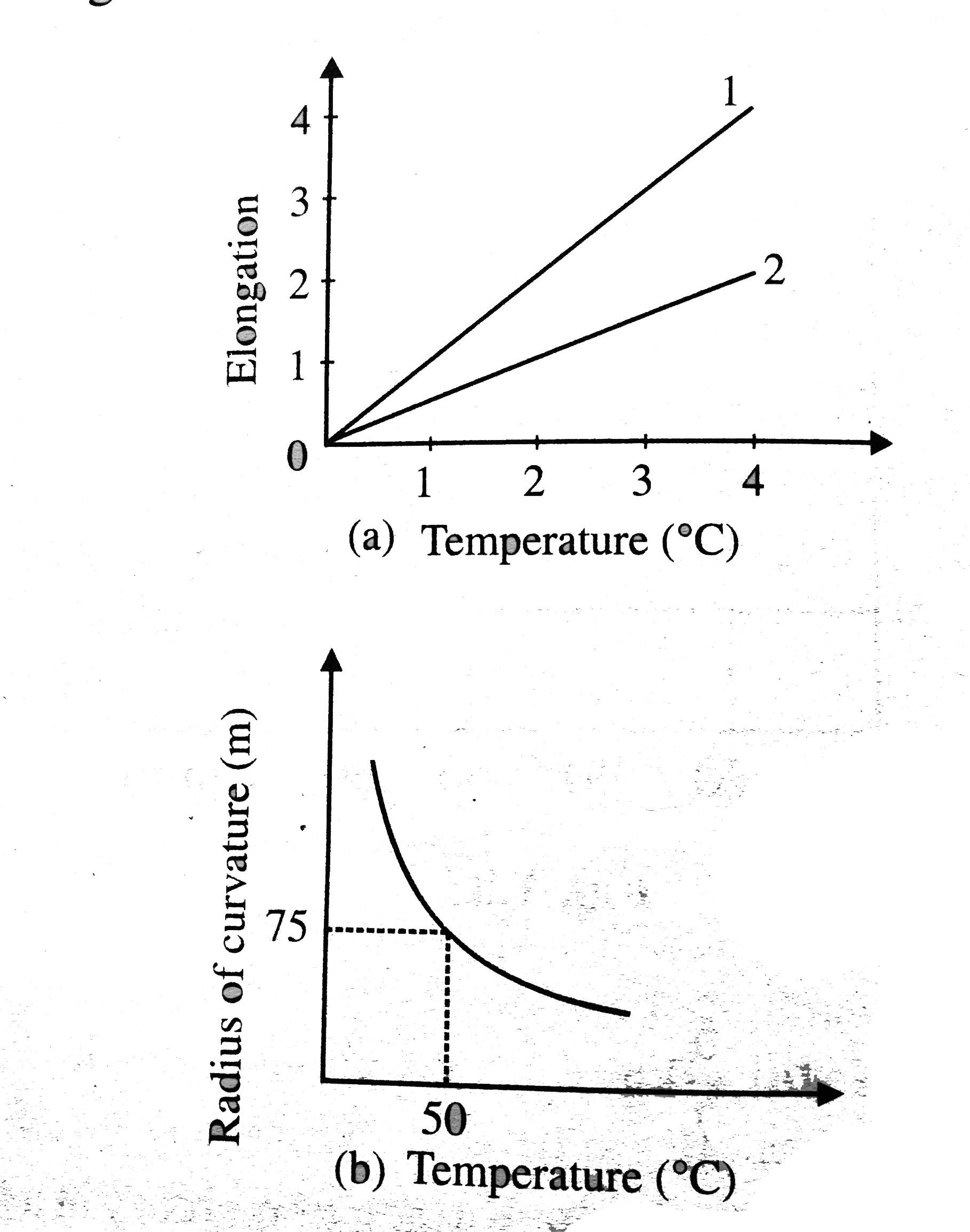
Figure. Shows the graphs of elongation versus temperature for two different metals. If these metals are employed to form a straight bimetallic strip of thickness 6 cm and heated, it bends in the form of an arc, the radius of cuvature chaging with temperature approximately as shown in the figure. The linear expansivities of the two metals areView SolutionQuestion 88
A system receives heat continuously at the rate of 10 W. The temperature of the system becomes constant at 70∘C when the temperature of the surroundings is 30∘C. After the heater is switched off, the system cools from 50∘C to 49.9∘C in 1 min. The heat capacity of the system is View SolutionQuestion 92
A piece of metal floats on mercury. The coefficients of volume expansion of the metal and mercury are γ1 and γ2 respectively. If the temperatures of both mercury and the metal are increased by an amount ΔT, the fraction of the volume of the metal submerged in mercury changes by the factor............View SolutionQuestion 93
A uniform brass disc of radius a and mass m is set into spinning with angular speed ω0 about an axis passing through centre of disc and perpendicular to the palne of disc. If its temperature increases from θ∘1C to θ∘2C with out disturbing the disc, what will be its new angular speed ?View SolutionQuestion 94
Calculate the compressional force required to prevent the metallic rod of length l cm and cross sectional area Acm2 when heated through t∘C from expanding lengthwise. Young's modulus of elasticity of the metal is E and mean coefficient of linear expansion is α per degree celsius.View SolutionQuestion 95
The coefficient of linear expansion of glass is αg per .∘C and the cubical expansion of mercury is λm per .∘C. The volume of the bulb of a mercury thermometer at 0∘C is V0 and cross section of the capillary is A0. What is the length of mercury column in capillary at T∘C, if the mercury just fills the bulb at 0∘C ?View SolutionQuestion 96
A 10kW drilling machine is used to drill a bore in a small aluminium block of mass 8.0kg. How much is the rise in temperature of the block in 2.5 minutes, assuming 50% of power is used up in heating the machine itself or lost to the surrounding? Specific heat of aluminium =0.91J/g∘C.View SolutionQuestion 97
A ball of thremal capacity 10cal/∘C is heated to the temperature of furnace it is then transferred into a vessel containing water. The water equivalent of vessel and the constents is 200 g. The temperature of the vessel and its contents rises from 10∘C to 40∘C. What is the temperature of furnace?View SolutionQuestion 100
Ice at 0∘C is added to 200 g of water initially at 70∘C in a vacuum flask. When 50 g of ice has been added and has all melted the temperature of the flask and contents is 40∘C. When a further 80 g of ice has been added and has all melted the temperature of the whole becomes 10∘C. Find the latent heat of fusion of ice. View SolutionQuestion 106
One end of a copper rod of uniform cross section and length 1.5 m is kept in contact with ice and the other end with water at 100∘C. At what point along its length should a temperature of 200∘C be maintained so that in the steady state, the mass of ice melting be equal to that of the steam produced in same interval of time. Assume that the whole system is insulated from surroundings:
[Lice=80cal/g,Lsteam=540cal/g]View SolutionQuestion 108
A 1-L flask contains some mercury. It is found that at different temperature, the volume of air inside the flask remains the same. What is the volume of mercury in the flask, given that the coefficient of linear expansion of glass=9×10−6/∘C and the coefficient of volume expansion of Hg=1.8×10−4/∘C ?View SolutionQuestion 113
The earth receives at its surface radiation from the sun at the rate of 1400Wm−2. The distance of the centre of the sun from the surface of the earth is 1.5×1011m and the radius of the sun is 7×108m. Treating the sun as a black body, it follows from the above data that its surface temperature is ......KView SolutionQuestion 114

Three rods of identical cross-sectional area and made from the same metal form the sides of an isosceles Delta ABC right angled at B. The points A and B are maintained at temperetures T and √2T, respectively in the steady state. Assuming that only heat conduction takes place, temperature of point C is View SolutionQuestion 117
An iron rod of length 50 cm is joined at an end to aluminium rod of length 100 cm. All measurements refer to 20_0 C . Find the length of the composite system at 1000 C. and its average coefficent of linear expansion. The coefficient o f linear expansion o f iron and aluminium are 10 xx 10_-6 0 C_-1 and 24 xx10_-6 0 C _-1 respectively.View SolutionQuestion 123
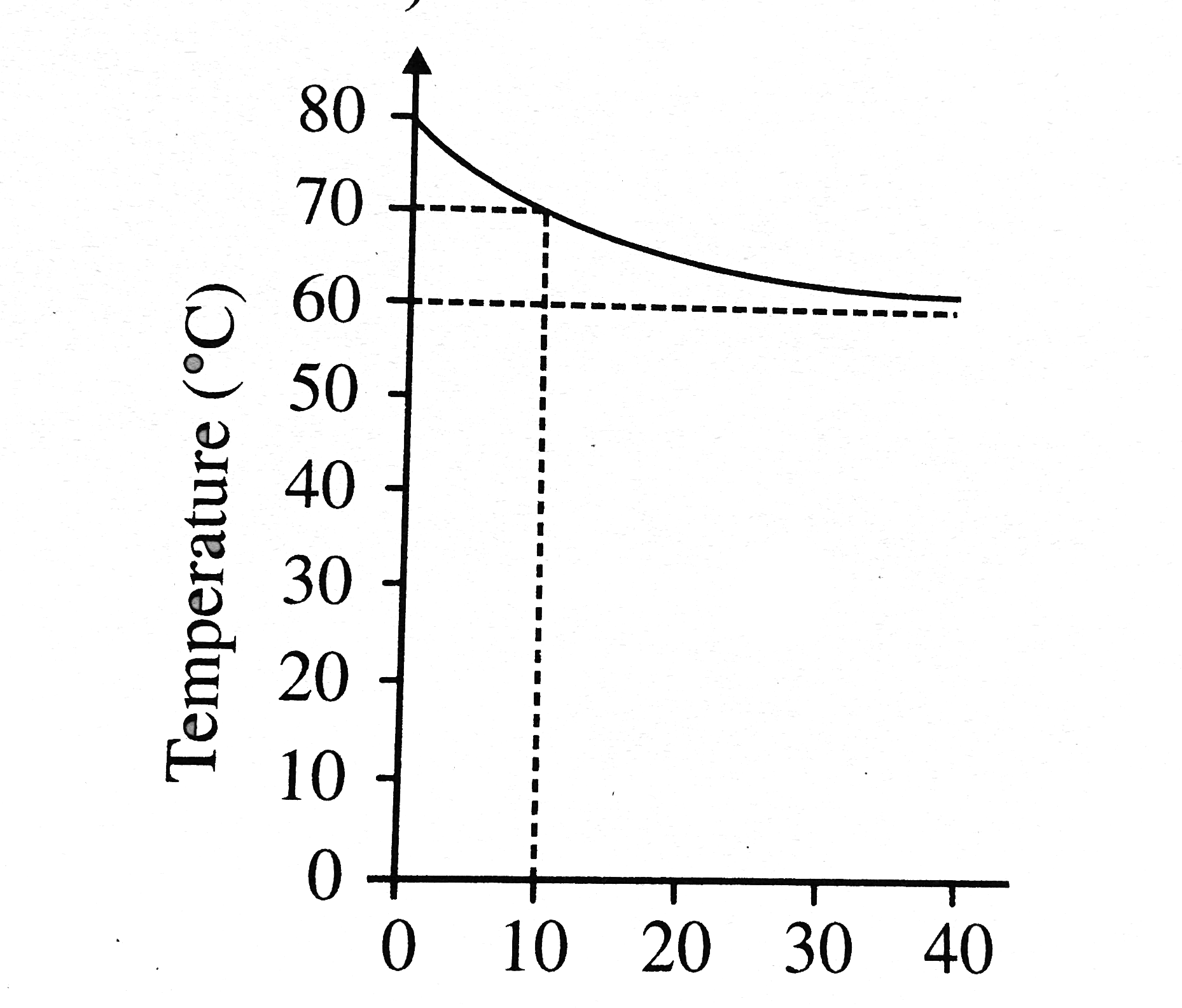
A vessel contains M grams of water at a certain temperature and water at certain other temperature is passed into it at a constant rate of mg/s. The variation of temeprature of the mixture with time is shown in Fig. The values of M and m are, respectively (the heat exhanged after a long time is 800 cal)View SolutionQuestion 124
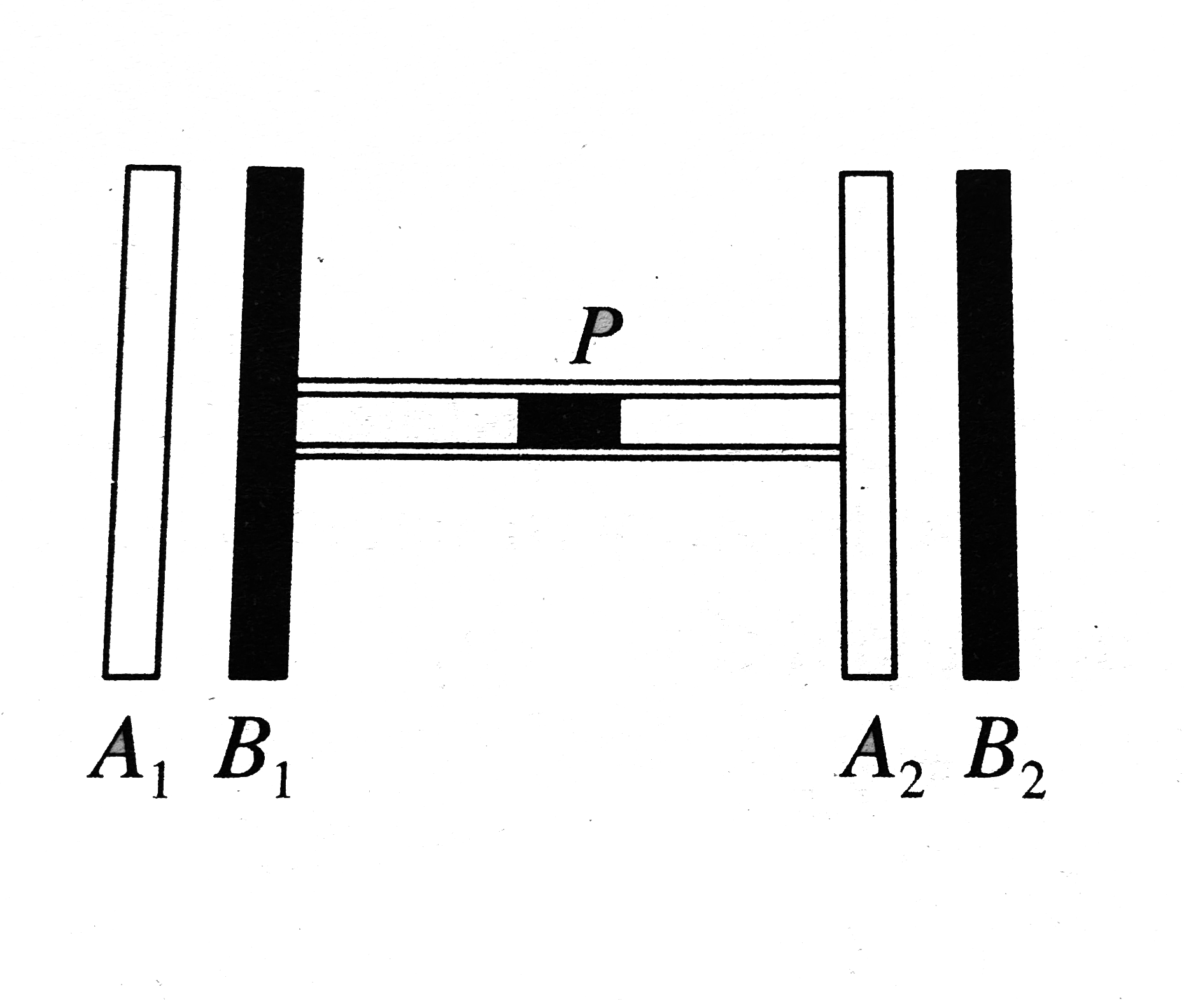
Two plates identical in size, one of black and rough surface (B1) and the other smooth and polished (A2) are in terconnected by a thin horizontal pipe with a mercury pellet at the centre. Two more plates A1 (identical to A2) and B2 (identical B1) are heated to the same temperature and placed closed to the plates B1, and A2 shown in Fig. The mercury pelletView SolutionQuestion 125
Two spheres of different materials one with double the radius and one-fourth wall thickness of the other are filled with ice. If the time taken for complete melting of ice in the larger sphere is 25 minutes and for smaller one is 16 minutes, the ratio of thermal conductivities of the materials of larger sphere to that of smaller sphere is:View SolutionQuestion 127
An earthen pitcher loses 1 g of water per minute due to evaporation. If the water equivalent of pitcher is 0.5 kg and the pitcher contains 9.5 kg of water, calculate the time required for the water in the pitcher to cool to 28∘C from its original temperature of 30∘C Neglect radiation effect. Latent heat of vapourization of water in this range of temperature is 580 cal/g and specific heat of water is 1kcal/gC∘View SolutionQuestion 130
A room at 20∘C is heated by a heater of resistence 20 ohm connected to 200 VV mains. The temperature is uniform throughout the room and the heati s transmitted through a glass window of area 1m2 and thickness 0.2 cm. Calculate the temperature outside. Thermal conductivity of glass is 0.2cal/mC∘ s and mechanical equivalent of heat is 4.2J/cal.View SolutionQuestion 132
One end of a copper rod of uniform cross section and length 1.5 m is kept in contact with ice and the other end with water at 100∘C. At what point along its length should a temperature of 200∘C be maintained so that in the steady state, the mass of ice melting be equal to that of the steam produced in same interval of time. Assume that the whole system is insulated from surroundings:
[Lice=80cal/g,Lsteam=540cal/g]View SolutionQuestion 141
A bar measured with a vernier caliper is found to be 180 mm long. The temperature during the measurement is 10∘C. The measurement error will be if the scale of the vernier caliper has been graduated at a temeprature of 20∘C. (α=1.1×10−5.∘C−1. Assume that the length of the bar does not change.)View SolutionQuestion 142
A closed cubical box is made of perfectly insulating material and the only way for heat to enter or leave the box is through two solid cylindrical metal plugs, each of cross sectional area 12cm2 and length 8cm fixed in the opposite walls of the box. The outer surface of one plug is kept at a temperature of 100∘C . while the outer surface of the plug is maintained at a temperature of 4(∘)C . The thermal conductivity of the material of the plug is 2.0Wm−1.∘C−1 . A source of energy generating 13W is enclosed inside the box. Find the equilibrium temperature of the inner surface of the box assuming that it is the same at all points on the inner surface.View SolutionQuestion 143
Two models of a windowpane are made. In one model, two identical glass panes of thickness 3 mm are separated with an air gap of 3 mm. This composite system is fixed in the window of a room The other model consist of a single glass pane of thickness 3 mm, the temperature difference being the same as for the first model. the ratio of the heat flow fot the double pane to that for the single pane is
(Kglass=2.5×10−4cal/s.m.∘C and Kair=6.2×10−6cal/s.m.∘C).View SolutionQuestion 146
Water at 0∘C was heated until it started to boil and then until it all changed to steam. The time required to heat water from 0∘C to 100∘C is 5 min and the time to change boiling water to steam is 28 minutes. If the flame supplied heat at a constant rate, the specific latent heat of vaporisation of water (neglecting heat losses, container etc. is (in J/g). (specific heat of water s =4.2J/g )View Solution
